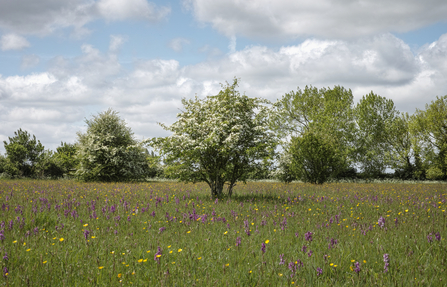
Winks Meadow by Steve Aylward
Grasslands swaying with wildflowers are part and parcel of Suffolk's image as a green county, made up of hedged fields, meadows and pastures. But without sensitive management, these grasslands soon become invaded by more vigorous plants that can overwhelm and replace what is a vital habitat for birds, invertebrates and animals.
The exact management requirements of an area of grassland, not only vary with the site location but also on the species present. The resources below are designed to help you decide what method of management is suitable for your site.
Before any kind of management is undertaken, it's important to survey the grassland to find out what wildflowers are already there. Meadows containing rare plants will need particularly careful management, so it's worth getting in touch.
Cutting/mowing
Cutting is an effective method of managing grassland because the timing, area and height of the cut can be easily adapted to suit an individual site. However, it is important to begin by carefully considering the following:
• The requirements of the wildlife interest present on the site. For example, if it is a ‘Spring Meadow’ plants will tend to flower early in the year, if it is a ‘Summer Meadow’ plants will flower later on.
• The resources available to you (i.e. the equipment, manpower and time available). Grassland needs management every year so it is important to think in the long term.
• The intended use of the land (e.g. hay cutting, grazing, public access, species protection).
In most situations, July is the best time for cutting, with a further cut in September/October often being beneficial. However, cutting times can be varied to suit local conditions. For example, a spring cut knocks back thistles and vigorous grasses that can sometimes take hold during the winter. While an autumn cut allows the grassland plants more opportunity to flower and set seed. In traditional hay meadows, cutting may take place from mid summer onwards.
After cutting, it is very important to rake off and remove the clippings. If left on, they can smother delicate plants and increase fertility which encourages rank growth at the expense of wildflowers. If clippings are left to dry for a few days after cutting, flowers can shed any ripe seed and insects are able to make their escape.
Depending on the resources and the size of the site, a grassland need not be cut all at once. In fact, mowing an entire grassland in one go can remove a valuable food source for insects and birds. It is therefore good practice to leave some grass uncut to overwinter. The best way to do this is to either cut your grassland in sections at varying times or, if you have room, to cut the edges of your grassland on rotation (leaving a different side uncut each year).
Where thistles, nettles and docks and particularly rush are prevalent it will be necessary to cut them back more frequently. Ragwort can also be a problem as it is invasive and poisonous to animals. However, always avoid the use of chemicals. Herbicides can cause damage by eradicating wildflowers and grasses as well as ‘weeds’. Fertilisers should never be used as they encourage the growth of a few vigorous species and the diversity of wildflowers will decline dramatically.
Cutting equipment
The type of cutting tools required will naturally depend on the size of your grassland and what is available to you. On a small meadow, hand scythes or a power strimmer can be used. On larger areas long grass can be cut for hay using a power scythe or a tractor drawn grass cutter. For such areas it is good practice to mow from the centre of the meadow outwards (or from one side to the other) to give
any ground nesting birds or small mammals the opportunity to escape into adjacent land.
Before cutting, remember to remove all rocks and obstructions which could damage equipment.
Grazing
Grazing with livestock (ponies, cows, goats or sheep) is a good way to manage grassland. It is especially suitable if you have a large area of grassland to manage or the grassland is on uneven or sloping ground. The best time to graze is usually in mid summer and mid autumn, as with cutting. If in doubt, seek advice about more exact grazing times.
If your grassland has become invaded by ‘weeds’, such as docks and thistles, you may chose to keep animals on over the summer to knock them back. However, this may not benefit insects and should only be done every few years.
Before considering grazing as a form of management it is worth considering the following points:
• Large grazing animals such as cattle or horses are more likely to erode and poach the soil than smaller ones such as sheep.
• Stock need to be properly cared for, with a reliable source of water and fencing to keep them in. In urban
areas they may also need protection from disturbance, for example, from dogs.
• Animal dung can change the plants growing in a grassland. Dung patches may become colonised by unwanted and competitive species such as nettles and thistles.
• The more livestock present in a field, the less choosy they are about what they eat. So large numbers can control vigorous grasses and invasive species.
However, to prevent overgrazing (which may encourage species such as ragwort) or undergrazing (encouraging vigorous unpalatable species) it may be best to seek advice about the number and type of grazing animals to use.
